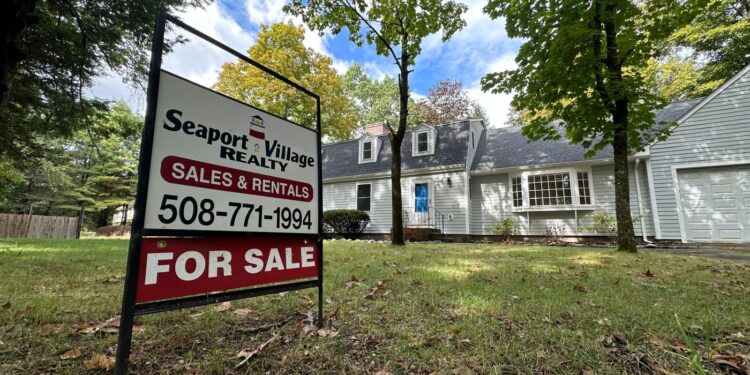
The housing market’s slump is dragging into its third year with affordability remaining a difficult hurdle for many would-be buyers with high asking prices and elevated mortgage rates limiting options or pricing people out of the market.
Homes are selling at their slowest pace and sitting on the market for the longest periods since the start of the pandemic. It is yet another blow for a housing market that has been in a prolonged slump and coming off its slowest year of sales in nearly three decades.
Existing home sales fell 0.7% overall last year to 4.06 million, the worst figure since 1995. The trend has continued in the early weeks of 2025, with pending home sales — when a seller accepts an offer — falling 9.4% for the four-week period ending Jan. 28, according to Redfin.
Pending home sales were down 9.4% year over year, the biggest decline since September 2023. The typical home that went under contract sat on the market for 54 days before an offer was accepted, the longest since March 2020 and a week longer than at the same time in 2023. During the pandemic-era housing boom, a typical home was selling in 35 days.
Homeowners have not had to budge on asking prices despite listings sitting on the market longer because of the limited supply. With fewer listings, there is less competition for offers and allows sellers to be patient to get the maximum value on their home.
There were just 1.15 million homes on the market at the end of December, according to the National Association of Realtors (NAR). Despite that being a double-digit increase from a year earlier, it was still well below the historical average of nearly 2 million.
The housing market is considered balanced when there is a five- to six-month supply, a level that hasn’t been reached since 2012.
“When the market isn’t competitive, some buyers think they should wait for costs to go down,” Jordan Hammond, a Redfin agent in Raleigh, N.C., said in a statement. “Now it’s pretty clear that sellers aren’t slashing asking prices and mortgage rates aren’t plummeting, so mindsets are shifting. People are starting to believe that if they want or need to move, and they can afford to, they should do it.”
Whether buyers can afford to get into the market is the main obstacle facing any type of recovery after two slow years. Mortgage rates have showed little sign of budging for more than two years and home prices have not fallen despite the decline in activity.
Existing home prices have increased for 18 consecutive months to a median of $404,000, according to the NAR, giving homeowners massive amounts of equity but creating a challenging environment for first-time buyers. Combined with high interest rates, monthly mortgage payments are putting homeownership out of reach for many. Redfin said the median monthly housing payment was $2,753 for the first four weeks of January, nearly a record high.
Mortgage rates have been stuck between 6.5% to 7% for more than two years, which add hundreds of dollars to monthly payments compared to a few years ago when rates were below 5%. Freddie Mac said last week the average on a 30-year, fixed-rate mortgage was 6.95%.
“With no immediate rate cuts on the horizon, mortgage rates are likely to stay steady in the near term,” said Emanuel Santa-Donato, SVP and chief market analyst at Tomo Mortgage. “The best move now is to shop aggressively for the best mortgage rate rather than holding out savings in the form of a rate reduction.”
The higher rate environment is also hurting homebuilders’ ability to increase supply with newly built homes by making it more difficult to find buyers and for projects to turn a profit. Builders are also still adjusting to the effects of inflation that made supplies and labor more expensive.
The limited amount of existing home inventory has provided builders with a modest boost heading into 2025, with new home sales increasing 3.6% in December, according to federal data. The pace of new home sales went up 6.7% compared to a year earlier.
“Builders are cautiously optimistic about the building market for 2025 given a post-election policy reset that seeks to eliminate unnecessary regulations,” said Carl Harris, chairman of the National Association of Home Builders.
Even with the potential for growth in new home construction, affordability issues will likely remain persistent. High rates increase monthly payments and new homes are still expensive, with the median sales price in December at $427,000.
President Donald Trump campaigned on reducing costs for Americans and has signed an executive order directing government agencies to find ways to lower housing costs and increasing the supply. He has said he would seek to remove regulations and standards that present obstacles for builders, though his plan for dealing with the affordability crisis has not been rolled out.
Have a news tip? Contact Austin Denean at [email protected] or at x.com/austindenean. Content from The National Desk is provided by Sinclair, the parent company of FOX45 News.






